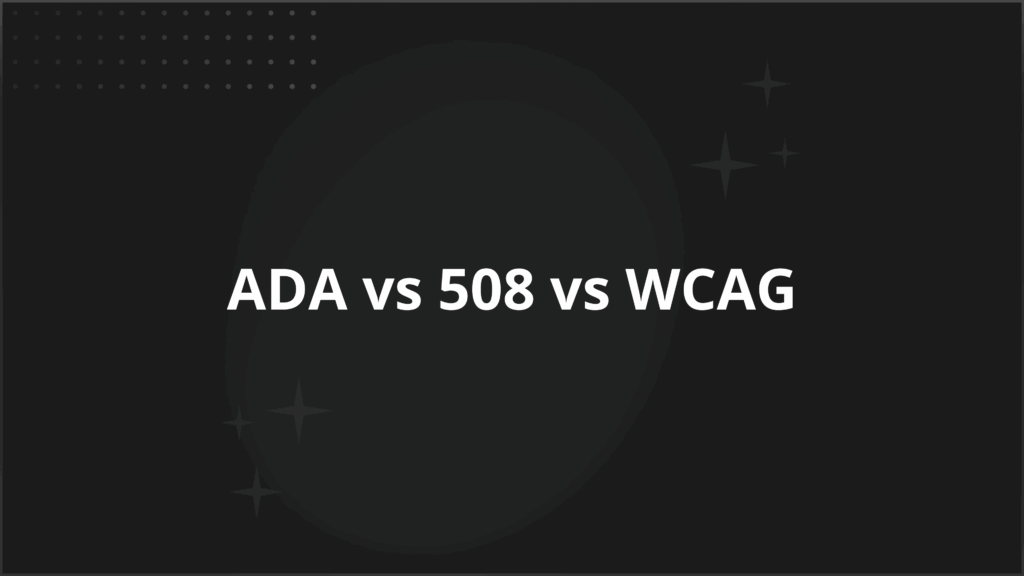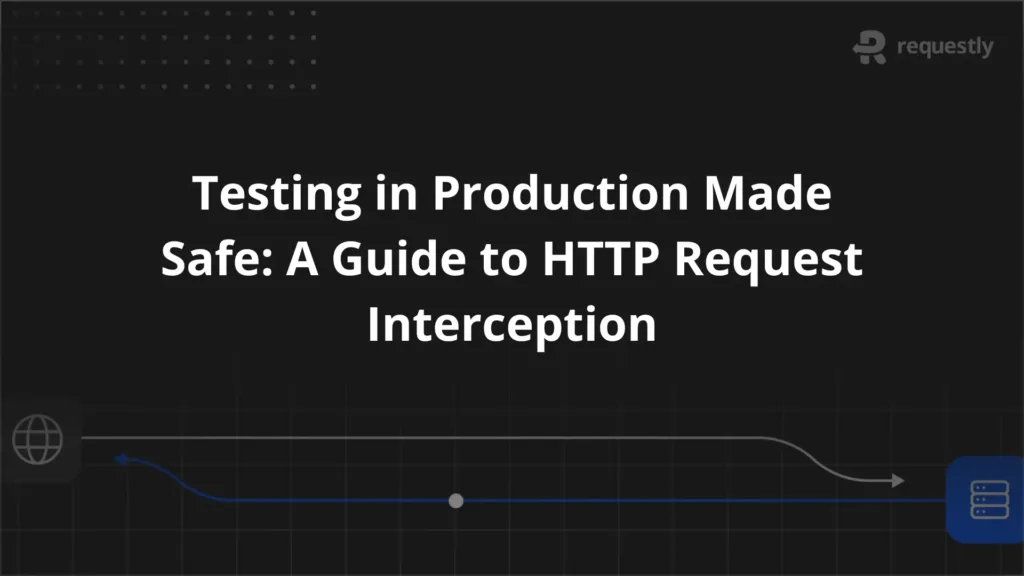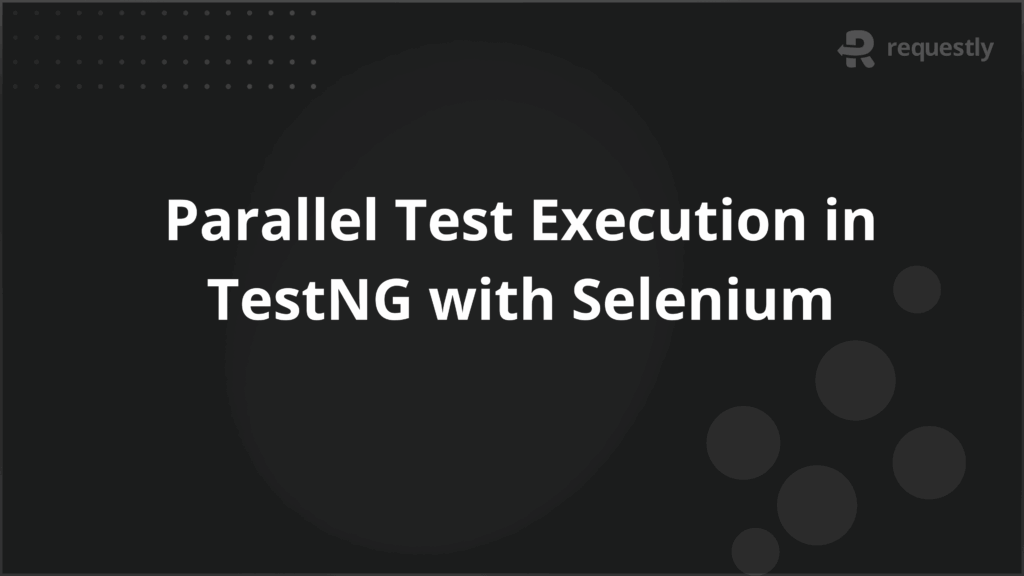ADA vs 508 vs WCAG


Web accessibility standards are essential to ensuring that digital content is usable by all individuals, including those with disabilities.
Understanding the key differences between ADA, Section 508, and WCAG helps organizations choose the right compliance path for their digital content.
Key Differences ADA vs Section 508 vs WCAG:
- ADA: Ensures equal access to digital services for both public and private entities.
- Section 508: Mandates accessibility for digital content used by federal agencies and contractors.
- WCAG: A globally recognized set of technical guidelines for web content accessibility.
- ADA vs Section 508: ADA applies to public and private entities, while Section 508 is specific to government digital content.
- WCAG vs ADA/508: WCAG provides a technical framework for developers to meet the requirements of ADA and Section 508.
The article delves into how these standards differ, when to apply them, and why they are important for building accessible digital content.
What is ADA (Americans with Disabilities Act)?
The Americans with Disabilities Act (ADA), signed into law in 1990, is a key piece of civil rights legislation to ensure that individuals with disabilities have the same rights and access to services, employment, and public spaces.
The ADA applies to various areas such as employment, transportation, and public accommodations, which include websites and digital services.
Key Requirements for Web Accessibility under ADA
Although ADA doesn’t explicitly cover websites, court rulings apply it to digital platforms. Entities must ensure website accessibility, including text for images, captions for videos, and compatibility with assistive technologies like screen readers and voice commands.
Benefits of ADA Compliance
Here are the key benefits of ADA compliance:
- Legal Protection: Compliance reduces the risk of legal challenges and lawsuits related to digital accessibility.
- Wider Audience: By making a website accessible, businesses can reach a broader audience, including individuals with disabilities who represent a significant portion of the population.
- Improved SEO: ADA-compliant websites tend to rank higher in search engines because accessible websites often adhere to SEO best practices, such as providing descriptive alt text for images.
What is Section 508?
Section 508 of the Rehabilitation Act of 1973 requires federal agencies and any organizations working with the government (such as contractors and subcontractors) to ensure that their digital content is accessible to people with disabilities.
This law applies to all federal agencies’ electronic and information technology (EIT), including websites, software applications, and other digital services.
Key Requirements of Section 508
Under Section 508, federal agencies must ensure their websites are fully accessible, which includes:
- Providing text equivalents for non-text content (like images or videos).
- Ensuring web content can be accessed by assistive technologies such as screen readers.
- Making sure that users can navigate websites using only a keyboard.
Differences Between Section 508 and ADA
Unlike the ADA, which applies to public and private organizations, Section 508 is specific to federal agencies and their contractors.
While the ADA addresses access to services and employment, Section 508 focuses on digital accessibility within government operations and activities. Section 508 aligns closely with the Web Content Accessibility Guidelines (WCAG) to ensure accessible content to individuals with disabilities.
What is WCAG (Web Content Accessibility Guidelines)?
The Web Content Accessibility Guidelines (WCAG) are a set of recommendations developed by the World Wide Web Consortium (W3C) to make web content more accessible to people with disabilities.
WCAG is widely recognized as the international standard for web accessibility, and it provides guidelines to help organizations create digital content that is usable by everyone, regardless of ability.
Key Principles of WCAG
The guidelines are structured around four core principles:
- Perceivable: Users must be able to perceive content, such as through text alternatives for non-text content and captions for multimedia.
- Operable: Users must be able to navigate content using a variety of methods, such as a keyboard or voice control.
- Understandable: Content must be presented in a way that users can understand, with clear navigation and consistent interfaces.
- Robust: Content must be compatible with current and future technologies, ensuring it remains accessible as technology evolves.
WCAG Compliance Levels (A, AA, AAA)
- Level A: The most basic web accessibility features that must be met.
- Level AA: The mid-range accessibility features that address common barriers to accessibility.
- Level AAA: The highest level of accessibility, addressing the most complex needs.
Why WCAG is Essential
Compliance with WCAG ensures that websites are usable by individuals with diverse disabilities, including visual, auditory, cognitive, and motor impairments. Moreover, WCAG compliance improves the overall usability and experience for all users, not just those with disabilities, leading to better user engagement and satisfaction.
Key Differences Between ADA, Section 508, and WCAG
Understanding the differences between ADA, Section 508, and WCAG is crucial for compliance. Here’s a clear breakdown in tabular format:
Standard | Scope | Focus | Target Audience |
ADA | Applies to both public and private entities | Accessibility for all public-facing websites | Businesses, services, and public spaces |
Section 508 | Federal agencies and contractors | Accessibility of digital content for federal agencies | U.S. federal agencies and contractors |
WCAG | Global, for all web developers | Detailed technical guidelines for web content accessibility | Web developers, designers, and organizations globally |
When and Why You Need to Comply with ADA, Section 508, and WCAG
Complying with ADA, Section 508, and WCAG is a legal obligation and a step toward inclusive design that benefits a wider audience.
Here’s when and why compliance matters:
When to Comply with ADA, Section 508, and WCAG
- ADA: The ADA applies to businesses, services, and public entities that offer digital services or products. Websites must be accessible to individuals with disabilities to avoid legal repercussions.
- Section 508: If your organization works with federal agencies or is a federal contractor, Section 508 requires your digital content to be accessible to employees and the public with disabilities.
- WCAG: WCAG is applicable for any website or web content, providing the technical framework needed to ensure accessibility. Adhering to WCAG ensures that you are meeting ADA and Section 508 requirements.
Why Compliance Matters:
- Legal Protection: Non-compliance with ADA or Section 508 can result in lawsuits and legal penalties. Compliance ensures that your website is legally safe.
- Reach and Inclusivity: Accessibility allows businesses to reach a broader audience, including individuals with disabilities, who are a significant and growing demographic.
- Better User Experience: Accessible websites improve the overall user experience, leading to better engagement and customer loyalty. They also help improve your SEO rankings as search engines favor user-friendly websites.
How to Achieve ADA, Section 508, and WCAG Compliance
Compliance with ADA, Section 508, and WCAG requires a systematic web design and development approach. Here’s how to get started:
- Conduct an Accessibility Audit: Begin by auditing your website using both manual and automated testing tools. This will help identify areas where your website fails to meet accessibility standards.
- Ensure Text Alternatives for Non-Text Content: Provide alt text for images, video captions, and audio content transcripts. This ensures that users with visual or auditory impairments can access the content.
- Ensure Keyboard Navigation: Ensure your website can be fully navigated using only a keyboard. This is critical for users with motor impairments who cannot use a mouse.
- Test with Assistive Technologies: To ensure compatibility, regularly test your website with tools like screen readers, voice recognition software, and magnification tools.
- Follow WCAG Guidelines: WCAG provides specific technical guidelines for accessibility. Ensure that your website meets at least the AA level for compliance, the most commonly required level for businesses.
- Stay Up to Date with Changes: Web accessibility standards evolve. Follow updates to the ADA, Section 508, and WCAG to ensure your site remains compliant.
ADA vs Section 508 vs WCAG: Which Standard Should You Follow?
Choosing the right accessibility standard depends on your organization’s requirements, target audience, and the legal framework you fall under. Here’s a quick guide:
- ADA (Americans with Disabilities Act): If you are a public-facing business or service, you should follow ADA. It ensures non-discrimination and equal access for people with disabilities. ADA compliance is primarily about user experience and ensuring all users can access your site, regardless of disability.
- Section 508: This standard applies specifically to U.S. federal agencies and contractors working with them. If you are a government entity or federal contractor, Section 508 compliance is a legal requirement for digital content accessibility.
- WCAG (Web Content Accessibility Guidelines): WCAG provides the technical framework for achieving compliance with ADA and Section 508. If you’re aiming for international accessibility, WCAG is the most comprehensive, offering guidelines for website design, content, and functionality to make them usable for everyone, including those with disabilities.
Benefits of Web Accessibility Beyond Compliance
Web accessibility isn’t just about meeting legal requirements; it has numerous benefits that go beyond compliance:
- Enhanced User Experience: Accessible websites improve navigation and readability, benefiting all users, not just those with disabilities.
- Wider Audience Reach: Accessibility expands your market, making your products or services available to millions of people with disabilities.
- SEO and Search Engine Ranking: Accessible websites tend to perform better in search rankings due to clear, well-structured content and alignment with SEO best practices.
- Corporate Social Responsibility: Embracing accessibility promotes inclusivity, boosts brand image, and builds trust with customers and partners.
Testing for ADA, Section 508, and WCAG Compliance
Effective testing is crucial to ensure your website complies with ADA, Section 508, and WCAG standards. Automated tools and manual checks can help identify and resolve common accessibility issues, ensuring that your site is inclusive for all users.
- Automated Issue Detection: Tools like BrowserStack can automatically detect common accessibility issues, such as missing alt text, low contrast, and heading structure errors, helping ensure your site is perceivable to users with visual impairments.
- Keyboard Navigation Testing: Verify that users can navigate your site using only a keyboard, a critical feature for individuals with motor disabilities. BrowserStack helps identify keyboard navigation issues, such as incorrect tab orders and focus management.
- Screen Reader Testing: Test with real devices using VoiceOver (Mac), NVDA (Windows), and TalkBack (Android) to evaluate how well your site works with screen readers, which are essential for users with visual impairments. This ensures that all content is announced correctly and readable.
- Color Contrast Analyzer: Use real-time tools to verify AA/AAA compliance for color contrast, ensuring that text is easily readable for individuals with low vision or color blindness. BrowserStack offers real-time scans for full-page and component-specific checks.
- Dynamic & Responsive Accessibility Checks: Ensure accessibility compliance for single-page applications (SPAs), dynamic content, and responsive layouts across multiple devices and screen sizes. BrowserStack supports testing across browsers, ensuring your site works seamlessly across various platforms.
Free Accessibility Testing: BrowserStack offers unlimited accessibility tests with automated WCAG compliance scans, helping you easily address common accessibility issues.
Conclusion
Web accessibility is not just a legal requirement; it’s an opportunity to enhance your website’s usability, expand your audience, and improve SEO. Whether you must comply with ADA, Section 508, or WCAG, ensuring your website is accessible benefits your users and your business.
By leveraging BrowserStack’s accessibility testing tools, you can ensure your website is accessible across devices and browsers, streamlining the process of achieving compliance while providing a better user experience.

Contents
- What is ADA (Americans with Disabilities Act)?
- Benefits of ADA Compliance
- What is Section 508?
- Key Requirements of Section 508
- Differences Between Section 508 and ADA
- What is WCAG (Web Content Accessibility Guidelines)?
- Key Principles of WCAG
- Why WCAG is Essential
- Key Differences Between ADA, Section 508, and WCAG
- When and Why You Need to Comply with ADA, Section 508, and WCAG
- How to Achieve ADA, Section 508, and WCAG Compliance
- ADA vs Section 508 vs WCAG: Which Standard Should You Follow?
- Benefits of Web Accessibility Beyond Compliance
- Testing for ADA, Section 508, and WCAG Compliance
- Conclusion
Subscribe for latest updates
Share this article
Related posts






















